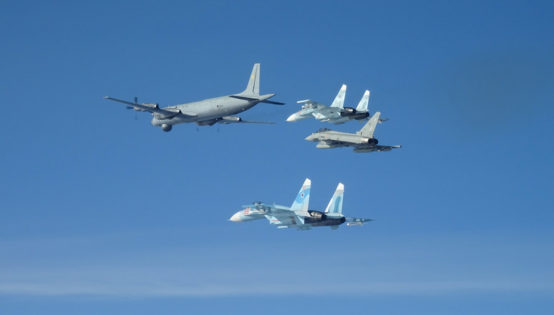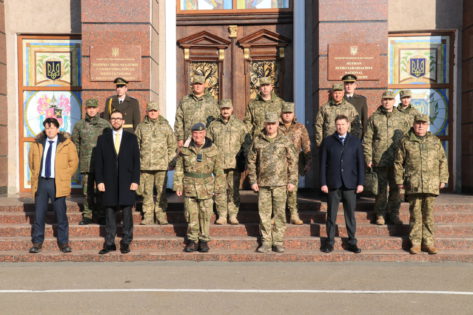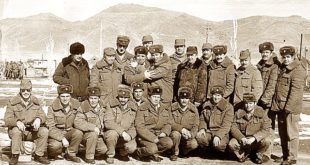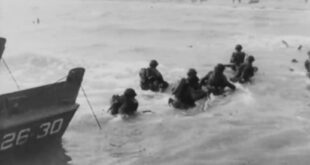The NATO Response Force
500 French troops assembled in Istres in southern France before deploying to Romania.
The first of many French forces have arrived in Romania as part of the NATO Response Force (NRF).
The soldiers, part of the French Army’s Chasseurs alpins unit (“Alpine Hunters”) arrived at Mihail Kogălniceanu International Airport on 28 February 2022. They are part of the NRF, which is being deployed to the eastern part of the Alliance in response to Russia’s unprovoked and unjustified invasion of Ukraine. The NRF ensures that the Alliance continues to have the speed, responsiveness and capability to defend NATO territory and populations.
On 25 February, the North Atlantic Council activated the NRF for the first time for defensive purposes.
This is the first time NATO has activated the NATO Response Force for collective defence and deterrence. It follows NATO’s activation of its defence response plans amid the biggest security crisis in Europe in decades, triggered by Russia’s massive military build-up and its invasion of Ukraine.
France leads this year’s highest-readiness element of the NATO Response Force, a multinational force comprised of up to 40,000 land, air, maritime and special operations personnel that NATO can deploy at short notice as needed.
NATO Secretary General Jens Stoltenberg welcomed the deployment: “Over the last weeks, we have increased our presence in the eastern part of the Alliance and now, we are for the first time in our history deploying the NATO Response Force. French troops have arrived in Romania as the lead element of this force. Our commitment to Article 5, our collective defence clause, is iron-clad. We will protect and defend every inch of NATO territory.”
Austin said that U.S. troops with join the force:
13 April: NATO Secretary General Jens Stoltenberg and the Foreign Minister of Ukraine, Dmytro Kuleba
We are seriously concerned by ongoing developments.
And NATO is monitoring the situation very closely.
In recent weeks, Russia has moved thousands of combat-ready troops to Ukraine’s borders.
The largest massing of Russian troops since the illegal annexation of Crimea in 2014.
Over the last days, several Ukrainian soldiers have been killed in eastern Ukraine.
I want to express my condolences for the recent losses suffered by the Ukrainian Armed Forces.
Russia’s considerable military build-up is unjustified, unexplained, and deeply concerning.
Russia must end this military build-up in and around Ukraine.
Stop its provocations.
And de-escalate immediately.
We regret Russia’s decision not to participate in the recent meeting at the OSCE to dispel concerns about its unusual military activities.
Russia must respect its international commitments.
NATO’s support for Ukraine’s sovereignty and territorial integrity is unwavering.
We do not, and will not recognise Russia’s illegal and illegitimate annexation of Crimea.
We continue to call on Russia to end its support for the militants in eastern Ukraine and withdraw its forces from Ukrainian territory.
NATO stands with Ukraine.
Allies continue to provide significant practical support so that Ukraine can better provide for its own security.
Ukraine’s new status as an Enhanced Opportunities Partner demonstrates how both sides benefit from our long-standing partnership.
We are helping to strengthen capabilities, including with training for the Ukrainian armed forces.
And Allies also participate in joint exercises.
We have stepped up our cooperation in the Black Sea region with more exercises and port visits.
And we support Ukraine’s wide-ranging reform agenda, which will make Ukraine more resilient.
And help advance Ukraine’s Euro-Atlantic aspirations.
CONTINUATION OF THE NATIONAL EMERGENCY WITH RESPECT TO UKRAINE
On March 6, 2014, by Executive Order 13660, the President declared a national emergency pursuant to the International Emergency Economic Powers Act (50 U.S.C. 1701-1706) to deal with the unusual and extraordinary threat to the national security and foreign policy of the United States constituted by the actions and policies of persons that undermine democratic processes and institutions in Ukraine; threaten its peace, security, stability, sovereignty, and territorial integrity; and contribute to the misappropriation of its assets.
On March 16, 2014, the President issued Executive Order 13661, which expanded the scope of the national emergency declared in Executive Order 13660, and found that the actions and policies of the Government of the Russian Federation with respect to Ukraine undermine democratic processes and institutions in Ukraine; threaten its peace, security, stability, sovereignty, and territorial integrity; and contribute to the misappropriation of its assets.
On March 20, 2014, the President issued Executive Order 13662, which further expanded the scope of the national emergency declared in Executive Order 13660, as expanded in scope in Executive Order 13661, and found that the actions and policies of the Government of the Russian Federation, including its purported annexation of Crimea and its use of force in Ukraine, continue to undermine democratic processes and institutions in Ukraine; threaten its peace, security, stability, sovereignty, and territorial integrity; and contribute to the misappropriation of its assets.
On December 19, 2014, the President issued Executive Order 13685, to take additional steps to address the Russian occupation of the Crimea region of Ukraine.
On September 20, 2018, the President issued Executive Order 13849, to take additional steps to implement certain statutory sanctions with respect to the Russian Federation.
The actions and policies addressed in these Executive Orders continue to pose an unusual and extraordinary threat to the national security and foreign policy of the United States. For this reason, the national emergency declared on March 6, 2014, and the measures adopted on that date, on March 16, 2014, on March 20, 2014, on December 19, 2014, and on September 20, 2018, to deal with that emergency, must continue in effect beyond March 6, 2021. Therefore, in accordance with section 202(d) of the National Emergencies Act (50 U.S.C. 1622(d)), I am continuing for 1 year the national emergency declared in Executive Order 13660.
9 April Russia Needs to Answer Questions Regarding Military Buildup Near Ukraine BY JIM GARAMONE, DOD NEWS
UPDATE: After numerous questions about a Russian buildup in Crimea and along the eastern border of Russia with Ukraine, Pentagon Press Secretary John F. Kirby finally got a bit exasperated and told Pentagon reporters that “these are great questions to put to [Defense Minister Sergey] Shoygu in Moscow.”
White House officials have classified the Russian buildup in the region as the largest since 2014, and many nations want to know why the Russians are doing this. NATO officials along with individual nations have asked Russia for an explanation and received weak responses about training or exercises.
Kirby said he has consistently spoken about the Russian actions as a buildup, “precisely because we don’t think that the Russians have been totally transparent about what they’re doing,” he said.
Kirby would not detail the scope of the Russian buildup or the equipment the Russian troops brought with them. He did say they are in Crimea — which is still part of Ukraine — and along the eastern border with Ukraine.
“I’m not going to talk about intelligence assessments or what we’re seeing,” Kirby said. “What we call on, is for the Russians to do exactly that, to tell the world what they’re doing, and with what forces, and what capabilities, and what their intentions are.”
The buildup “is only causing more instability and more insecurity in a part of the world where there’s already been too much strife and too much violence,” Kirby said.

Earlier this month, NATO reported that fighter jets scrambled 10 times on Monday, March 29, 2021, to shadow Russian bombers and fighters during an unusual peak of flights over the North Atlantic, North Sea, Black Sea and Baltic Sea. In all, NATO aircraft intercepted six different groups of Russian military aircraft near Alliance airspace in less than six hours.
In the High North, Norwegian F-16s scrambled after radars spotted two groups of Russian military aircraft flying near Norway’s coast. The Norwegian jets intercepted two Tu-95 Bear bombers, which continued to fly south over the North Sea prompting the United Kingdom and Belgium to scramble Typhoon and F-16 fighters, respectively. Later in the day, the Norwegian F-16s intercepted two Tu-160 Blackjack bombers over international waters.
NATO radars also detected three Russian military aircraft near Allied airspace over the Black Sea. Turkish, Romanian and Bulgarian fighter aircraft took to the skies to track the Russian aircraft until they had left the area. Separately, Italian fighter aircraft intercepted a Russian Il 38 maritime patrol aircraft which was escorted by fighter jets over the Baltic Sea flying into and out of Kaliningrad.
“The men and women at NATO’s two Combined Air Operations Centres in Uedem, Germany, and Torrejón, Spain, quickly responded to unidentified aircraft near the Alliance’s borders by launching fighters from Norway, the United Kingdom, Belgium, Italy, Romania, Bulgaria and Turkey to investigate and protect allied airspace”, Brigadier Hansen said, adding that NATO’s air policing mission is a “truly collective effort”.
Russian military aircraft often do not transmit a transponder code indicating their position and altitude, do not file a flight plan, or do not communicate with air traffic controllers, posing a potential risk to civilian airliners. The Russian aircraft intercepted on Monday never entered Alliance airspace, and the interceptions were conducted in a safe and routine manner. Safeguarding the integrity of Alliance members’ airspace is a peacetime task contributing to NATO’s collective defence, and falls under the overall responsibility of the Supreme Allied Commander Europe, Gen. Tod Wolters.

RFE/RL Ukraine service weighs in on Ukraine
The United States is expressing concern about what it called ongoing Russian aggression against Ukraine amid reports of a buildup of Russian troops along Ukraine’s border and in Crimea.
Secretary of State Antony Blinken spoke by phone with his Ukrainian counterpart, Dmytro Kuleba, and U.S. General Mark Milley, chairman of the Joint Chiefs of Staff, called top military leaders in Russia and Ukraine, the State Department and Pentagon said on March 31.
Blinken reaffirmed U.S. support for Ukraine “in the face of Russia’s ongoing aggression” and “expressed concern about the security situation in eastern Ukraine,” the State Department said.
Defense Department spokesman John Kirby said the Pentagon is aware of Ukrainian military reports concerning Russian troop movements near Ukraine’s borders.
“Russia’s destabilizing actions undermine the de-escalation intentions that had been achieved through an OSCE-brokered agreement back in July of last year,” Kirby told a briefing, referring to a cease-fire brokered by the Organization for Security and Cooperation in Europe.
“We are discussing our concerns about this increase in tensions and cease-fire violations and regional tensions with NATO allies,” Kirby said.
The OSCE’s civilian Special Monitoring Mission to Ukraine has reported hundreds of cease-fire violations in recent days. On March 26, four Ukrainian soldiers were killed and two others injured in the eastern part of the country.
The Ukrainian military said its soldiers were hit by a mortar attack it blamed on Russian troops. Russia denies having a military presence in eastern Ukraine, where it backs separatist forces.
Milley spoke with General Valery Gerasimov, the Russian Armed Forces chief of staff, and General Ruslan Khomchak, chief of the general staff of Ukraine’s Armed Forces.
Kirby referred questions about the specifics of Milley’s calls to his office.

Khomchak on March 30 accused Moscow of conducting a buildup near the Ukraine-Russia border and reiterated claims that pro-Moscow separatists continue to violate the July cease-fire.
The buildup is taking place “under the guise of preparing for strategic exercises” and is in addition to thousands of troops in combat brigades, regiments, and supply units deployed in the occupied Donbas with the support of Russian regular troops, the Ukrainian army chief said in an interview with Voice of America.
“The Armed Forces of Ukraine respond accordingly to such actions of our eastern neighbor,” Khomchak said. “We are preparing for all possible provocations and reactions to the actions of the enemy.”
Khomchak first made the accusations of a military buildup in a speech to Ukraine’s parliament on March 30.
The comments drew a response from Russian President Vladimir Putin during a March 30 video conference call with French President Emmanuel Macron and German Chancellor Angela Merkel, the Kremlin said.
Putin placed the blame for tensions on Ukraine and urged Kyiv to enter into direct dialogue with local separatist forces.
“The Russian side expressed serious concern over the escalation of armed confrontation that is being provoked by Ukraine along the line of contact and its effective refusal to implement the agreements of July 2020…to strengthen the cease-fire regime,” the Kremlin said in a statement late on March 30.
Kremlin spokesman Dmitry Peskov, in comments to reporters on March 31, said Putin has not drawn any “red lines” regarding the situation in eastern Ukraine.
“In general, the issues on the agenda were the absence of any alternatives to compliance with the Minsk accords and the problem situation that has taken shape in connection with the noncompliance with these agreements,” Peskov said, according to TASS, referring to a 2015 agreement brokered by France and Germany.
A statement from the French presidency indicated that during the video conference call Macron and Merkel urged Putin to take steps to de-escalate.
“The need for Russia to make a determined commitment to stabilize the cease-fire in Ukraine and work out a way out of the crisis while respecting the Minsk Agreements was underlined,” the Elysee Palace said.
Germany, Russia, France, and Ukraine are part of the so-called Normandy Format set up to try to resolve the simmering conflict.
Cease-fire violations and flare-ups in violence in eastern Ukraine are common. Fighting between government forces and Russia-backed separatists has killed more than 13,000 people since April 2014.
 Soldier of Fortune Magazine The Journal of Professional Adventurers
Soldier of Fortune Magazine The Journal of Professional Adventurers





